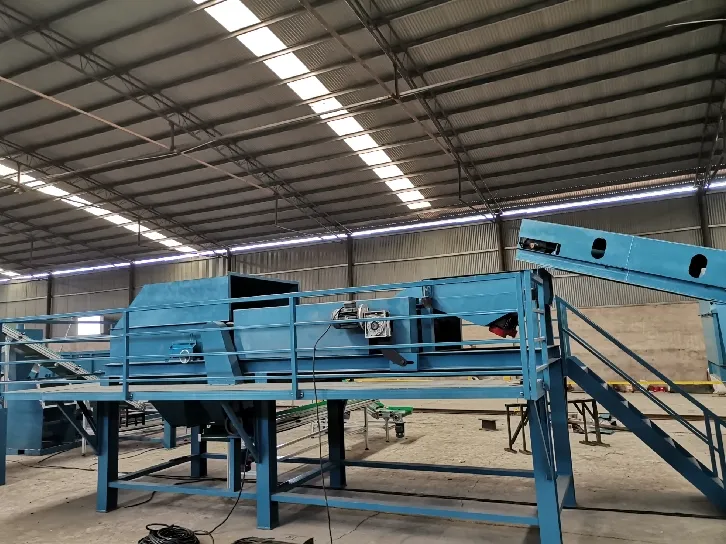
12 月 . 04, 2024 16:06 Back to list
The Importance of Aluminum Scrap Recycling Plants
Aluminum recycling has gained immense significance in today's industrial landscape, driven by growing awareness of environmental sustainability and the need for resource conservation. Aluminum scrap recycling plants play a crucial role in this process, transforming waste materials into valuable raw materials. As a versatile and widely used metal, aluminum possesses unique properties that make it an ideal candidate for recycling, which contributes to a circular economy. This article explores the necessity and benefits of aluminum scrap recycling plants, their processes, and their overall impact on the environment.
The Growing Demand for Aluminum
Aluminum is one of the most widely used materials in various industries, including automotive, aerospace, packaging, and construction. Its lightweight nature, coupled with high strength and resistance to corrosion, makes aluminum an attractive option for manufacturers. With the increasing global demand for aluminum products, responsible sourcing and recycling of aluminum are more important than ever. Recycling aluminum saves energy, reduces mining activity, lowers greenhouse gas emissions, and alleviates the burden on landfills.
How Aluminum Scrap Recycling Plants Operate
Aluminum scrap recycling plants are specialized facilities designed to process scrap aluminum, such as old cans, car parts, and construction debris. The recycling process typically involves several steps
1. Collection Scrap aluminum is collected from various sources, including households, industrial suppliers, and demolition sites. This collection is essential for creating a steady supply of material for processing.
2. Sorting Once collected, the aluminum scrap is sorted to remove contaminants and separate different grades of aluminum. This can be done using manual labor, magnetic separation, and advanced technologies like air-jet systems, ensuring that only the highest quality aluminum enters the recycling stream.
3. Shredding and Cleaning The sorted aluminum is then shredded into smaller pieces, making it easier to handle and process. The shredded material is cleaned to remove any remaining dirt, oils, or non-aluminum components.
4. Melting The clean aluminum is melted in large furnaces at high temperatures. This process requires significantly less energy compared to the energy-intensive process of producing aluminum from bauxite ore. In fact, recycling aluminum uses about 95% less energy than primary production.

5. Casting After melting, the molten aluminum is poured into molds to create ingots or other forms suitable for manufacturing. Once solidified, these ingots are ready to re-enter the production cycle.
Environmental Benefits of Recycling Aluminum
The environmental benefits of aluminum scrap recycling are profound. One of the primary advantages is the substantial energy savings associated with melting recycled aluminum compared to producing new aluminum from raw materials. The energy saved can power entire homes for years, demonstrating the significant impact of recycling on reducing energy consumption.
In addition to energy savings, recycling aluminum also conserves natural resources. It reduces the need for mining bauxite, thereby decreasing the habitat destruction, water pollution, and other environmental issues associated with extraction. Moreover, recycling aluminum significantly lowers greenhouse gas emissions compared to primary production, helping to mitigate climate change.
Economic Advantages
In addition to environmental benefits, aluminum scrap recycling plants contribute to economic growth. They create jobs in collection, sorting, and processing, and also stimulate local economies by providing raw materials to manufacturers. The recycling industry has become a vital sector, supporting sustainable practices and promoting circular economy principles.
Challenges in Aluminum Recycling
Despite these advantages, aluminum recycling faces challenges such as contamination in the scrap stream and fluctuating market prices for recycled materials. Achieving higher recycling rates requires improved public awareness, better collection methods, and technological advancements in sorting and processing.
Conclusion
Aluminum scrap recycling plants are indispensable components of global efforts toward sustainability and resource efficiency. By transforming scrap aluminum into reusable materials, these plants play a vital role in conserving energy, protecting the environment, and promoting economic growth. As awareness of these issues continues to rise, the role of aluminum recycling will only become more critical, paving the way for a greener, more sustainable future. Encouraging responsible recycling habits and supporting the development of advanced recycling technologies will further enhance the benefits derived from aluminum recycling.
Latest news
Unveiling the Power of Eddy Current Separator
NewsSep.25,2024
Transform Your Home Recyclin:home metal shredder
NewsSep.25,2024
The Future of Waste Management with Recycling Line Picker
NewsSep.25,2024
The Benefits of a Metal Recycling Plant
NewsSep.25,2024
Revolutionize Material Separation with Onwang Technology
NewsSep.25,2024
Innovative Waste Management: Unveiling the MSW Sorting Plant
NewsSep.25,2024